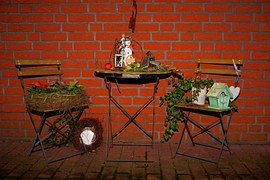Overlooked Outdoor Maintenance Every Homeowner Should Remember
You spent all weekend perfecting your patio lights, but that cracked gutter you ignored last year? It’s quietly plotting its revenge. Outdoor living spaces need care, just not the kind you only notice when something breaks. Here’s a run-through of outdoor maintenance tasks homeowners often skip, sometimes until it’s too late.
Your Gutters Aren’t Self-Cleaning
Out of sight, out of mind. Until a storm hits and your overflowing gutters turn your backyard into a pond. Leaves, dirt, and critters love calling your gutters home. Check them at least twice a year. A small plastic scoop or gloved hand usually does the trick. Skip this step, and you’ll soon meet mold on your walls or water pooling near your foundation. Not fun. Not cheap either.
Decks Don’t Just Fade, They Rot
Sure, your wooden deck looked great five years ago. Now? It’s turning gray and soft in spots. Sunlight, rain, and foot traffic wear it down more than we like to admit. Give it a quick wash every few months. Sand and re-stain once a year, or as soon as it starts to feel rough to the touch. If the boards wiggle or sound hollow, it’s time for a more serious checkup. Don’t wait until someone’s foot goes through it during a barbecue.
Plants Are Not Furniture
That shrub isn’t just decoration, it’s alive and growing. And it can cause damage if ignored. Trim plants away from walls and fences. Vines may look romantic until they start cracking your siding. Tree roots? Let’s just say they don’t care about your plumbing. If something’s creeping where it shouldn’t, it’s better to cut back now than dig up concrete later.

Outdoor Furniture Isn’t Invincible
That chair may say “weather-resistant,” but it still hates the rain. Fabrics fade. Metal rusts. Wood warps. Cover cushions or store them when not in use. Wipe down frames monthly to avoid grime build-up. A little effort keeps things looking sharp and spares you the awkward moment when your guest sits on a mildewed pillow.
Driveways and Paths Need More Than a Rinse
A stained or cracked driveway doesn’t scream “welcome.” Small cracks become big ones fast, especially with temperature changes. Pressure wash once a year. Fill cracks as soon as they show. And if oil leaks from your car, clean it up before it stains permanently. Concrete maintenance isn’t glamorous, but it saves a ton down the road. Literally.
Fences Don’t Fix Themselves
Wobbly panels and rusted hinges tend to be ignored until they fall over during a windstorm. Give fences a wiggle check every few months. Wood needs sealing. Metal needs rust checked. And gates deserve hinges that work without sounding like a horror movie.
Outdoor living spaces offer peace, fresh air, and the occasional grilled feast. But behind the joy sits upkeep that’s easy to skip—until it bites back. So grab that hose, tighten those screws, and maybe give your shrubs a little tough love. Your future self (and wallet) will thank you.…







 A reputable moving company will have experienced movers trained in handling different types of furniture. They will carefully dismantle your furniture pieces using the right tools and techniques, ensuring that each part is properly labeled for easy reassembly later on. This will help prevent any damage or loss during transit. Once your belongings reach their destination, the movers will reassemble your furniture according to your instructions. They have the expertise to quickly put everything back together correctly so that you don’t have to spend hours figuring out where each piece goes.
A reputable moving company will have experienced movers trained in handling different types of furniture. They will carefully dismantle your furniture pieces using the right tools and techniques, ensuring that each part is properly labeled for easy reassembly later on. This will help prevent any damage or loss during transit. Once your belongings reach their destination, the movers will reassemble your furniture according to your instructions. They have the expertise to quickly put everything back together correctly so that you don’t have to spend hours figuring out where each piece goes.

 Having a home office means you can spend more time with your family. You don’t need to leave the house for an extended period, and you can be flexible about when you take breaks or go on holiday. It allows parents to participate in their children’s lives instead of relying solely on daycare or after-school activities.
Having a home office means you can spend more time with your family. You don’t need to leave the house for an extended period, and you can be flexible about when you take breaks or go on holiday. It allows parents to participate in their children’s lives instead of relying solely on daycare or after-school activities.
 When looking for a plumbing company, it is essential to do your research. There are many companies out there, and you want to make sure you find the right one for your needs. You can read online reviews, talk to friends and family, or even ask your neighbours who they use.
When looking for a plumbing company, it is essential to do your research. There are many companies out there, and you want to make sure you find the right one for your needs. You can read online reviews, talk to friends and family, or even ask your neighbours who they use. If you know someone who has used a plumbing company before, ask for referrals. It is a great way to get first-hand information about the quality of service. Word-of-mouth is one of the best ways to find a good plumbing company.
If you know someone who has used a plumbing company before, ask for referrals. It is a great way to get first-hand information about the quality of service. Word-of-mouth is one of the best ways to find a good plumbing company. Once you have narrowed down your options, it is time to get an estimate. It will give you an idea of how much the job will cost and if the company is within your budget. Make sure to get a detailed estimate to know precisely what is included in the price. After getting an estimate, it is time to decide and choose a plumbing company. Remember, the cheapest option is not always the best one. Consider all the factors we have discussed before making your final decision.
Once you have narrowed down your options, it is time to get an estimate. It will give you an idea of how much the job will cost and if the company is within your budget. Make sure to get a detailed estimate to know precisely what is included in the price. After getting an estimate, it is time to decide and choose a plumbing company. Remember, the cheapest option is not always the best one. Consider all the factors we have discussed before making your final decision.


 Consider having a pre-sell home inspection to be able to do some needed repairs around the home. This will help enhance the look and appeal of the house and also for potential buyers will give them an assurance that the home has the needed authorization for one to move in. Fixing leaks, repairing broken fixtures and adding a new coat of paint will improve the house significantly.
Consider having a pre-sell home inspection to be able to do some needed repairs around the home. This will help enhance the look and appeal of the house and also for potential buyers will give them an assurance that the home has the needed authorization for one to move in. Fixing leaks, repairing broken fixtures and adding a new coat of paint will improve the house significantly.
 finances are in order before you start building a home. Building a home might be too exciting.
finances are in order before you start building a home. Building a home might be too exciting. Quality and value should be one of the driving factors when you are building your home. It is crucial to note that the best custom houses are not constructed in a day but several months and even years.
Quality and value should be one of the driving factors when you are building your home. It is crucial to note that the best custom houses are not constructed in a day but several months and even years.

 Associations manage condos. The associations ensure the shared amenities and facilities are maintained and repaired when there is a need. For them to manage the community, the owners are required to pay a certain rate that goes into this service. It is important to know what the fees, for such amount will guide in deciding whether to buy the condo or not for such charges remain constant.
Associations manage condos. The associations ensure the shared amenities and facilities are maintained and repaired when there is a need. For them to manage the community, the owners are required to pay a certain rate that goes into this service. It is important to know what the fees, for such amount will guide in deciding whether to buy the condo or not for such charges remain constant.
 of applications in pathways, driveways ad patios and much more. It is a fashionable and cost-efficient way to transform old patios and walkways into stunning designs that are attractive to the eye.
of applications in pathways, driveways ad patios and much more. It is a fashionable and cost-efficient way to transform old patios and walkways into stunning designs that are attractive to the eye. Decorative stamped concrete are easy to integrate into any home design and remodeling project. Stamped concrete installation involves forming new concrete, adding custom color, bull floated and then troweled to give a smooth and trendy appeal. Stamped concrete form a one-piece layer and can last for years. Decorative concrete can be applied over an existing concrete, hence, ideal for anyone with a bad patio, driveway or pool deck.
Decorative stamped concrete are easy to integrate into any home design and remodeling project. Stamped concrete installation involves forming new concrete, adding custom color, bull floated and then troweled to give a smooth and trendy appeal. Stamped concrete form a one-piece layer and can last for years. Decorative concrete can be applied over an existing concrete, hence, ideal for anyone with a bad patio, driveway or pool deck.